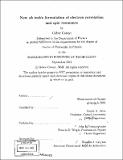| dc.contributor.advisor | Tomás A. Arias. | en_US |
| dc.contributor.author | Csányi, Gábor, 1973- | en_US |
| dc.contributor.other | Massachusetts Institute of Technology. Dept. of Physics. | en_US |
| dc.date.accessioned | 2005-08-23T18:51:59Z | |
| dc.date.available | 2005-08-23T18:51:59Z | |
| dc.date.copyright | 2001 | en_US |
| dc.date.issued | 2001 | en_US |
| dc.identifier.uri | http://hdl.handle.net/1721.1/8282 | |
| dc.description | Thesis (Ph. D.)--Massachusetts Institute of Technology, Dept. of Physics, 2001. | en_US |
| dc.description | Includes bibliographical references (leaves 96-100). | en_US |
| dc.description.abstract | We explore a new class of computationally feasible approximations of the two-body density matrix as a finite sum of tensor products of single-particle operators. Representing correlations by a single tensor product leads to the recently proposed "natural orbital functional." We show that this theory is no more accurate than Hartree-Fock in describing the homogeneous electron gas for the range of densities typically found in the valence regions of solids. We then present a new density-matrix functional within this tensor-product framework which performs well both for the homogeneous electron gas as well as atoms. For the electron gas, it is very accurate at high densities, and comparable to Hartree-Fock at metallic valence densities. For atoms it is on par with previous density-matrix functionals and the best density-functional methods. We demonstrate the utility of first principles computational methods in interpreting Electron Spin Resonance experiments. We propose a new structure for the fundamental excitation of the reconstructed 30Ê» partial dislocation in silicon. The isolated atom in the defect, or soliton, has an unusual structure involving a five-fold coordinated atom near the dislocation core. The unique electronic structure of this defect is consistent with the electron spin resonance signature of the hitherto enigmatic thermally stable R center of plastically deformed silicon. This identification suggests the possibility of an experimental determination of the density of solitons, a key defect in understanding the plastic flow of the material. | en_US |
| dc.description.abstract | (cont.) The recently introduced Projector Augmented Wave (PAW) method is used to compute hyperfine parameters for the azafullerene C59N. The results are in much better agreement with experiment than previous all-electron calculations. The previously employed method of obtaining hyperfine parameters by rescaling the pseudo-density is not sufficiently accurate in this case and the full PAW projector formalism is needed. We contrast the two methods by looking at the specific case of hydrogenated pyridine. In the last chapter we collect the ingredients from the literature for the first ab initio calculation of the g tensor in extended systems. We show how to carry out the calculation within the context of the PAW formalism, and test the required approximations by calculating the spin-orbit splitting in semiconductors. | en_US |
| dc.description.statementofresponsibility | by Gábor Csányi. | en_US |
| dc.format.extent | 100 leaves | en_US |
| dc.format.extent | 6342469 bytes | |
| dc.format.extent | 6342225 bytes | |
| dc.format.mimetype | application/pdf | |
| dc.format.mimetype | application/pdf | |
| dc.language.iso | eng | en_US |
| dc.publisher | Massachusetts Institute of Technology | en_US |
| dc.rights | M.I.T. theses are protected by copyright. They may be viewed from this source for any purpose, but reproduction or distribution in any format is prohibited without written permission. See provided URL for inquiries about permission. | en_US |
| dc.rights.uri | http://dspace.mit.edu/handle/1721.1/7582 | |
| dc.subject | Physics. | en_US |
| dc.title | New ab initio formulation of electron correlation and spin resonance | en_US |
| dc.type | Thesis | en_US |
| dc.description.degree | Ph.D. | en_US |
| dc.contributor.department | Massachusetts Institute of Technology. Department of Physics | |
| dc.identifier.oclc | 50420077 | en_US |
